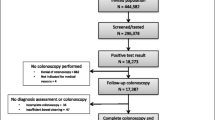Abstract
Two faecal occult blood tests, a simple chemical test Haemoccult and an immunological test, Fecatwin Sensitive/Feca EIA, were offered to 3,225 asymptomatic individuals as screening for colorectal cancer. One thousand three hundred and four (44%) completed and returned the tests and of these 126 (9.7%) were found to be positive - Haemoccult 40 (3%) and Feca EIA 106 (8.1%). Five cancers (4 Dukes' Stage A, 1 Dukes' Stage C) and 23 adenomas greater than 1 cm were detected - rates of 3.8 per 1000 persons screened and 17.7 per 1000 persons screened respectively. Of the five cancers identified 5 were Feca EIA positive and 3 were Haemoccult positive. Of the 23 adenomas greater than 1 cm diameter identified, J1 were Feca EIA positive and 20 were Haemoccult positive. Seventy-eight Feca EIA positive subjects were investigated and no neoplastic disease was identified. Whilst this sensitive immunological test increases the yield of carcinomas, the high false positive rate makes it unsuitable for population screening for colorectal cancer in its present form.
Similar content being viewed by others
Rights and permissions
About this article
Cite this article
Armitage, N., Hardcastle, J., Amar, S. et al. A comparison of an immunological faecal occult blood test Fecatwin sensitive/FECA EIA with Haemoccult in population screening for colorectal cancer. Br J Cancer 51, 799–804 (1985). https://doi.org/10.1038/bjc.1985.124
Issue Date:
DOI: https://doi.org/10.1038/bjc.1985.124
- Springer Nature Limited
This article is cited by
-
Comparaison du rapport coût/efficacité de deux tests de dépistage des tumeurs colo-rectales dans un centre d’examen de sante
Acta Endoscopica (1990)
-
Is there a preference for different ways of performing faecal occult blood tests?
International Journal of Colorectal Disease (1990)
-
Screening for colorectal cancer: A critical review
World Journal of Surgery (1989)
-
Colorectal carcinoma and Haemoccult
International Journal of Colorectal Disease (1987)
-
Screening for colorectal cancer
International Journal of Colorectal Disease (1986)




